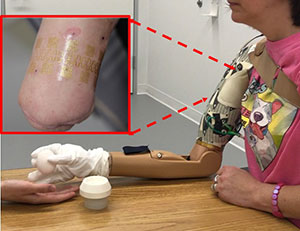Article
New soft, stretchable electronic devices, similar to temporary tattoos, could change the way people undergo medical tests, control prosthetic devices, and more.
University of Illinois researchers recently demonstrated the devices in Nature Biomedical Engineering, thanks to contributions of 13 current and former researchers, postdoctoral fellows, and faculty members at the Beckman Institute for Advanced Science and Technology.

John Rogers, a faculty member at Northwestern University, an adjunct professor of mechanical science and engineering at Illinois and a Beckman affiliate, said the devices are sometimes called epidermal electronics. The paper demonstrated that they can be scaled up from the size of a postage stamp “to practical systems that can cover entire body parts — arms, back, legs, and head — by use of a collection of innovative approaches in materials science, device design, and advanced manufacturing.”
The devices can be used for a variety of purposes, Rogers said, including in prosthetics control with amputees and in brain monitoring.
“The latter relies on circuit layouts that are compatible with magnetic resonance imaging,” he said.
Limei Tian, a former Beckman Institute Postdoctoral Fellow who is now working as an assistant professor in biomedical engineering at Texas A & M, led the research.
“We designed and developed large-area, soft, and ultrathin electronic interfaces for long-term electrophysiological recordings,” she said. “These interfaces are designed to be MRI-compatible that can be used for simultaneous electrophysiological recordings, and structural and functional MRI.”
Psychology Professor Florin Dolcos and Beckman Institute Postdoctoral Fellow Matthew Moore contributed by showing the devices could be used during a variety of brain tests and inside an MRI scanner.
Moore said the electronic devices can be worn for days. They can be used for electroencephalograms both outside and inside the MRI scanner.
Moore and Beckman Institute Postdoctoral Fellow Ben Zimmerman added psychological tests to the publication, showing that researchers could collect the expected brain signals with the devices.
All the work, including the MRI scans, was conducted within the Beckman Institute.
Dolcos said the paper represents years’ worth of work and demonstrates how expertise in imaging at Beckman is useful across disciplines. The research also required the expertise of others at Beckman, including bioengineering Professor Brad Sutton, the technical director of Beckman’s Biomedical Imaging Center, and Ryan Larsen, a research scientist who is an expert in MRI, as well as psychology Professors Monica Fabiani and Gabriele Gratton, who are experts in multimodal brain imaging.
Dolcos said the involvement of Beckman Institute Postdoctoral Fellows was crucial as the program is designed to encourage them to work with different faculty members and bridge disciplines. In this case, the work allowed a merging of engineering, neuroscience, and cognitive psychology.
“From our perspective, we use measures of brain function to understand the mind,” Dolcos said. “Engineers create the tools. What’s really exciting is when they come together.”

Zimmerman helped with the imaging aspect of the paper and actually wore the electronic patches on his scalp for a few days as part of the research.
“The coolest parts of this technology is that the electrodes conform directly to the skin,” Zimmerman said, which means a human can wear them continuously for a few days, even while working out or showering, with no change to one’s daily lifestyle.
Such continuity would allow for having an EEG several days in a row without the time-consuming process of attaching nodes to the scalp. Babies could also wear the electronic patches, or a test could be conducted while the wearer is moving around, Zimmerman said.
The paper’s collaborative nature combines an important advance in materials science with ways the technology can be used, Zimmerman said. Many people at the Beckman Institute helped with the latter, he said.
“We’re pooling our knowledge to create something new,” he said.
Fabiani said her collaboration on the paper is one of several with Rogers and his research group, and called the paper “a breakthrough.”
Gratton said he and Fabiani often discuss their needs for measuring the brain with Rogers’ group, whose researchers create the materials and electronics that make it possible.
Illinois alumnus Aadeel Akhtar, who conducted research at Beckman with aerospace engineering Professor Timothy Bretl, said the devices offer an improvement from current, conventional methods of prosthetic control, which embed muscle sensors in a socket that can shift or become uncomfortable over time. The soft, stretchable material allows more accurate and consistent muscle sensor recordings that can dramatically improve a patient’s daily control of a prosthesis.
Akhtar is the founder and CEO of startup PSYONIC, which is working to lower the cost and improve technology associated with prosthetic devices.
“The (stretchable electronic) device we designed also opens up the possibility of incorporating stimulation electrodes to give users sensory feedback in addition to motor control,” Akhtar said. “This will enable users to have a single, seamless patch that can do everything they need to control and feel from their prosthetic device.”
Beckman Institute for Advanced Science and Technology